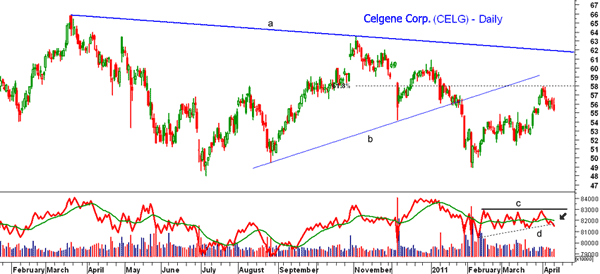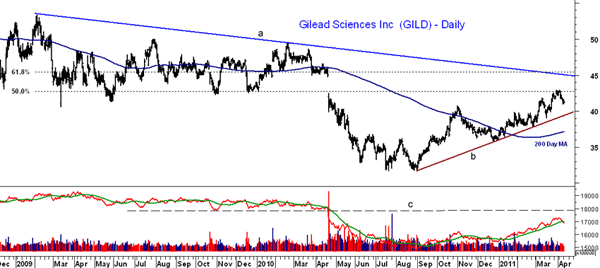The charts for two industry titans show lingering weakness, and investors may want to look for lower-risk ways to profit from a coming resurgence in the biotech sector.
As I mentioned weeks ago in “Bottom Fishing in Biotech,” I like biotech overall and expect the sector to do well as we head into the summer months. There should be some good buying opportunities for the sector’s best stocks on a further market correction.
However, two biotech giants, both members of the Nasdaq 100, look weak technically and would not be on my buy list.
Though some fundamental analysts think that Celgene Corp (CELG) and Gilead Sciences (GILD) are bargains at current levels, their charts suggest that both could still get cheaper over the next few months.
Chart Analysis: Celgene Corp. (CELG) is a $25+ billion company that is a manufacturer of drug therapies for cancer and inflammatory disorders. CELG peaked in August 2008 at $77.38 and reached a low in March 2009 at $36.90.
- In February, CELG violated its uptrend going back to the 2009 lows, as well as the short-term support at line b
- The rebound from the 2011 lows has reached the $58 level, which is the 61.8% retracement resistance level from the November 2009 highs. There is further resistance at $61
- The daily on-balance volume (OBV) did not make new highs on the recent rally (line c) and has just dropped below support at line d. The heavy volume on the recent decline weakened the technical outlook
- There is short-term support for CELG at $54.80 with stronger support in the $52.60 area. If this level is broken, then a decline to the support in the $48-$49 area does look likely
NEXT: Why Gilead Sciences (GILD) Shouldn't Make Your Buy List Either
|pagebreak|Gilead Sciences Inc. (GILD) is a $32 billion dollar biopharmaceutical company that originally concentrated on drugs to treat HIV and influenza before branching out into treatment for pulmonary diseases. CELG also peaked in August 2008 when it reached a high price of $57.63.
- GILD bottomed in October 2008 as the overall market was plunging and then rallied up to a high of $53.28 in March 2009
- In the summer of 2010, GILD formed a short-term double bottom at $31.76 and has just reached the 50% retracement resistance from the March 2009 highs
- The daily chart has stronger resistance at the April 2010 gap between $44.76 and $45.20. A majority of investors who bought GILD in 2009 are still in the red and would be expected to sell at higher levels
- The daily OBV has just dropped below its weighted moving average (WMA) and is still well below the resistance from the heavy selling a year ago (line c)
- The uptrend (line b) at $39.40 is still intact on the daily chart, and if broken, there is further support at $38. The 200-day moving average is turning up and is at $37.10, which is a likely downside target
What It Means: While a further decline is likely to set up a good entry in some of my favorite biotech stocks, including Dendreon Corporation (DNDN) and Savient Pharmaceuticals, Inc (SVNT), both of which have already rallied sharply from the lows, there are quite a few other biotechs, like CELG and GILD, that I expect to underperform.
Some of the more positive-looking biotech stocks would only be attractive at lower levels, but there are several I am watching closely and would write about if low-risk entries materialize.
How to Profit: Given all this renewed interest in biotech stocks, these two industry giants are often at the top of many lists due to their size and relatively low price levels. Though it is still possible that GILD can maintain its uptrend, CELG looks much weaker.
For the biotech portion of your portfolio, there certainly seem to be better choices. If you are long either of these stocks currently, I would recommend that you have your stops in place or at least hedge your exposure with covered calls.























